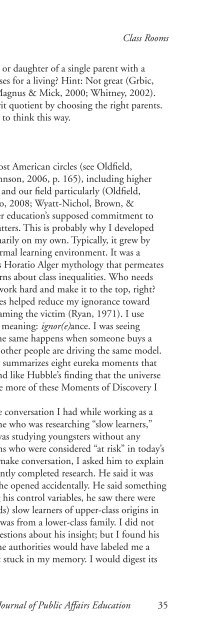WINTER 2012 - National Association of Schools of Public Affairs and ...
WINTER 2012 - National Association of Schools of Public Affairs and ...
WINTER 2012 - National Association of Schools of Public Affairs and ...
You also want an ePaper? Increase the reach of your titles
YUMPU automatically turns print PDFs into web optimized ePapers that Google loves.
Blue-Collar Teaching<br />
Before him, in 1962, Michael Harrington’s The Other America: Poverty in the<br />
United States talked <strong>of</strong> a hidden America <strong>of</strong> the underclass (1962/1997). Before<br />
Harrington, President Roosevelt in his 1936 inaugural speech spoke <strong>of</strong> one<br />
third <strong>of</strong> a nation ill-housed, ill-clad, <strong>and</strong> ill-nourished. We are a nation divided<br />
by class, overlaid with other differences such as race <strong>and</strong> gender. Ernst Bloch<br />
(1977) once argued that certain social contradictions persist over time, even if<br />
they manifest themselves differently in different epochs. His point is that racism<br />
<strong>and</strong> sexism have always existed, but so have class distinctions. But class is the<br />
real issue. Take away the economic sanctions or power that sexism <strong>and</strong> racism<br />
possess, <strong>and</strong> much <strong>of</strong> the sting <strong>of</strong> these two forms <strong>of</strong> discrimination is removed.<br />
Many studies point to the growing gap between the rich <strong>and</strong> poor in the<br />
United States (Congressional Budget Office, 2010; DeNavas-Walt, Proctor, &<br />
Smith 2011; Yen, 2011). Objectively, rich <strong>and</strong> poor exist in America, although<br />
few want to admit they are anything but part <strong>of</strong> the middle class (Hacker, 1971).<br />
Kennedy <strong>and</strong> Schultz (2011, pp. 62–64) describe class—along with race, gender,<br />
region, <strong>and</strong> religion—as one <strong>of</strong> the major fault lines in American politics. Class<br />
has <strong>of</strong>ten been used to divide America, or it has served as a rallying cry or point <strong>of</strong><br />
debate in numerous policy issues ranging from tax cuts to welfare to labor policy.<br />
CLASS AND THE AMERICAN UNIVERSITY<br />
Many factors explain why class is overlooked in American politics. But why<br />
in the university, <strong>and</strong> why among pr<strong>of</strong>essors, are class distinctions <strong>of</strong>ten invisible?<br />
There are two basic reasons. One is the push for universities to become marketdriven<br />
entities; the second is the class nature <strong>of</strong> the pr<strong>of</strong>essorate.<br />
Market-Driven Education<br />
According to Schultz (2005), the fiscal crises <strong>of</strong> states have recently<br />
pushed higher education to develop market-driven curricula. From a high in<br />
the 1960s <strong>and</strong> early ’70s when states <strong>and</strong> the federal government provided<br />
generous funding to exp<strong>and</strong> their public systems to educate the baby boomers,<br />
state universities now receive only a small percentage <strong>of</strong> their money from the<br />
government. In 2004, the State <strong>of</strong> New York constituted only 29% <strong>of</strong> SUNY’s<br />
funding <strong>and</strong> 31% <strong>of</strong> CUNY’s (New York State <strong>Public</strong> Higher Education<br />
Conference Board, 2004). By 1998, New York was spending more on its prisons<br />
than on higher education (Gonnerman, 1998). In 1991, states provided 74%<br />
<strong>of</strong> the funding for public universities; in 2004 it was down to 64%, <strong>and</strong> state<br />
systems in Illinois, Michigan, <strong>and</strong> Virginia were down to 25%, 18%, <strong>and</strong> 8%<br />
respectively (Dillon, 2005).<br />
The fiscal crisis <strong>of</strong> higher education has produced the corporate university.<br />
Colleges increasingly use corporate structures <strong>and</strong> management styles to run<br />
the university (Bok, 2003; Geiger, 2004; Washburn, 2005). This includes<br />
ab<strong>and</strong>oning the American <strong>Association</strong> <strong>of</strong> University Pr<strong>of</strong>essors (AAUP) shared<br />
Journal <strong>of</strong> <strong>Public</strong> <strong>Affairs</strong> Education 75

















